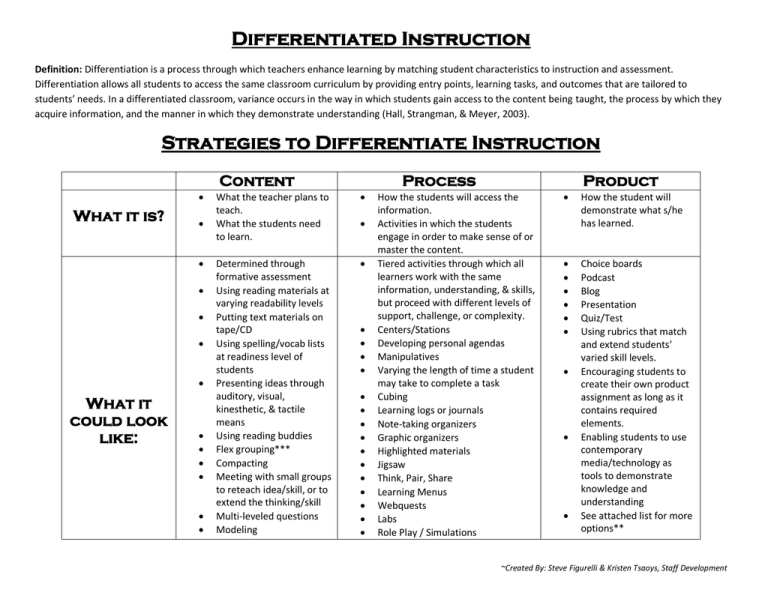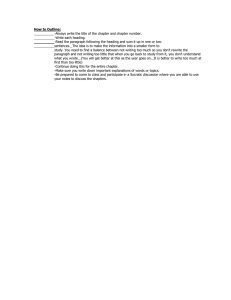Differentiated Instruction Strategies to Differentiate Instruction
advertisement

Differentiated Instruction Definition: Differentiation is a process through which teachers enhance learning by matching student characteristics to instruction and assessment. Differentiation allows all students to access the same classroom curriculum by providing entry points, learning tasks, and outcomes that are tailored to students’ needs. In a differentiated classroom, variance occurs in the way in which students gain access to the content being taught, the process by which they acquire information, and the manner in which they demonstrate understanding (Hall, Strangman, & Meyer, 2003). Strategies to Differentiate Instruction Content What it is? What it could look like: Process What the teacher plans to teach. What the students need to learn. Determined through formative assessment Using reading materials at varying readability levels Putting text materials on tape/CD Using spelling/vocab lists at readiness level of students Presenting ideas through auditory, visual, kinesthetic, & tactile means Using reading buddies Flex grouping*** Compacting Meeting with small groups to reteach idea/skill, or to extend the thinking/skill Multi-leveled questions Modeling Product How the students will access the information. Activities in which the students engage in order to make sense of or master the content. Tiered activities through which all learners work with the same information, understanding, & skills, but proceed with different levels of support, challenge, or complexity. Centers/Stations Developing personal agendas Manipulatives Varying the length of time a student may take to complete a task Cubing Learning logs or journals Note-taking organizers Graphic organizers Highlighted materials Jigsaw Think, Pair, Share Learning Menus Webquests Labs Role Play / Simulations How the student will demonstrate what s/he has learned. Choice boards Podcast Blog Presentation Quiz/Test Using rubrics that match and extend students’ varied skill levels. Encouraging students to create their own product assignment as long as it contains required elements. Enabling students to use contemporary media/technology as tools to demonstrate knowledge and understanding See attached list for more options** ~Created By: Steve Figurelli & Kristen Tsaoys, Staff Development **Reproduced from How to Differentiate Instruction in Mixed-Ability Classrooms by Carol Ann Tomlinson, 2001 pg. 89** Figure 13.2 Product Possibilities -Design a web page -Develop a solution to a community problem -Create a public service announcement -Write a book -Design a game -Generate & circulate a petition -Write a series of letters -Present a mime -Design & create needlework -Lead a symposium -Build a planetarium -Conduct a series of interviews -Develop a collection -Submit writings to a journal, magazine, or newspaper -Interpret through multimedia -Design a structure -Design & conduct an experiment -Collect & analyze samples -Plan a journey or an odyssey -Make an etching or a woodcut -Write letters to the editor -Design political cartoons -Formulate & defend a theory -Conduct a training session -Design & teach a class -Do a demonstration -Present a news report -Write a new law & plan for its passage -Make learning centers -Create authentic recipes -Choreograph dances -Present a mock trial -Make a plan -Compile & annotate a set of Internet resources -Design a new product -Write a series of songs -Create a subject dictionary -Make and carry out a plan -Design a simulation -Write a musical -Develop a museum exhibit -Be a mentor -Write or produce a play -Compile a newspaper -Develop an exhibit -Conduct an ethnography -Write a biography -Present a photo-essay -Hold a press conference -Develop & use a questionnaire -Conduct a debate -Make a video documentary -Create a series of illustrations -Write poems -Develop tools -Design or create musical instruments -Develop an advertising campaign -Compile a booklet or brochure -Draw a set of blueprints -Present a radio program -Do a puppet show -Create a series of wall hangings -Go on an archeological dig -Design & make costumes -Present an interior monologue -Generate charts or diagrams to explain ideas ~Created By: Steve Figurelli & Kristen Tsaoys, Staff Development ***The basis for grouping varies between responding to student readiness, interest, or learning style. A useful tool for making purposeful decisions about how to group students is TAPS – an acronym used to refer to four different options for grouping: Total Group (T), alone (A), in partners (P), and in small groups (S). The table below illustrates the features of each of these groupings as well as provides suggestions for situations that lend themselves especially appropriate for utilizing each. ~Created By: Steve Figurelli & Kristen Tsaoys, Staff Development







